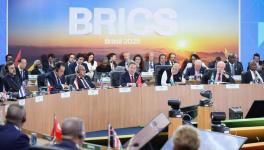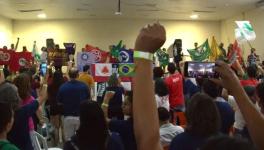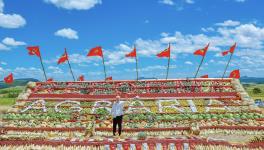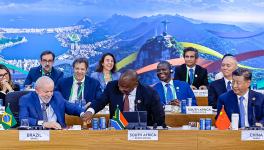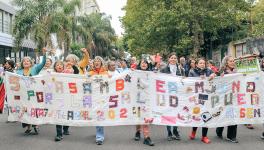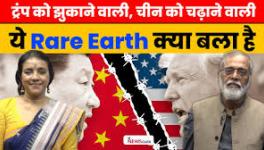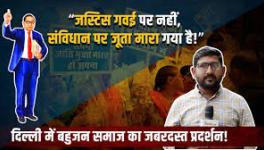Eduardo Galeano, The World Cup and the Corporatization of Soccer
Over the next few weeks, we will see all that is beautiful and all that is damned in soccer at the FIFA World Cup in Brazil. Hundreds of millions will swoon at the sight of the gods of the global game -- Argentina’s Lionel Messi, Portugal’s Cristiano Ronaldo, Uruguay’s Luis Suarez, Italy’s Andrea Pirlo, England’s Wayne Rooney -- plying their exquisite trade across the newly built or expensively refurbished stadiums on which Brazil, according to the Wall Street Journal, has spent $3.6 billion over the last few years.
The 32 national teams arriving in that country will, however, be confronted with another, far more sobering reality. Soccer-crazy Brazil has been in revolt over the World Cup -- over, in particular, the staggering sums that have been siphoned from the public purse into a string of gargantuan, desperately-behind-schedule construction projects for the competition. Last year, there were protests, some of which were violently suppressed, in more than 120 Brazilian cities during the somewhat pointless warm-up tournament that the governing body of world soccer, FIFA, runs a year before the World Cup begins.
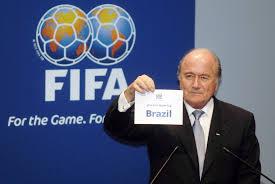
Image Courtesy: en.wikipedia.org
For lovers of the game, in his celebrated masterpiece Soccer in Sun and Shadow, the great Uruguayan writer Eduardo Galeano long ago caught the way the spectacle of soccer and the spectacle of reality intertwined. Of the Brazilian protests, he recently observed: “Brazilians, who are the most soccer-mad of all, have decided not to allow their sport to be used any more as an excuse for humiliating the many and enriching the few. The fiesta of soccer, a feast for the legs that play and the eyes that watch, is much more than a big business run by overlords from Switzerland. The most popular sport in the world wants to serve the people who embrace it. That is a fire police violence will never put out.”
Huge global sporting contests, their boosters promise, will transform the nature of the host country. The billions South Africa poured into hosting the World Cup were touted by some as a form of development. The result? The month-long euphoria of the contests was followed by the hangover of dealing with an expensive unused or underused stadium infrastructure scattered across that developing country. (Host countries pay FIFA for the privilege of hosting the competition, then foot the bill for most of the tournament, while FIFA takes most of the revenues.) Today, something similar is happening in Brazil where, as Simon Kuper and Stefan Szymanksi have noted, there has been “a transfer of wealth from Brazil as a whole to various interest groups inside and outside the country. This is not an economic bonanza. Brazil is sacrificing a little bit of its future to host the World Cup.”
This is just one symptom of a corporate takeover of “the beautiful game” that has reached the saturation point. Since the neoliberal 1980s, Brazil, like many other South American countries, has been in the business of exporting its soccer talent to the rest of the world. As Galeano once noted of his own country's leg drain, “In Uruguay... soccer is an export industry that scorns the domestic market. The continuous outflow of good players means mediocre professional leagues and ever fewer, ever less fervent fans.”
Corporate sponsorship is officially prohibited from team shirts during the World Cup, but elsewhere, from the T-shirts on their chests to the laces on their shoes, even in one controversial case their underpants, the players are advertisements for the multinational apparel companies who make their uniforms. And the elite among them are employed as brand ambassadors by corporations during the tournament; so expect to see Messi and Ronaldo advertising soft drinks and airlines during gamebreaks.
We all need an antidote to soccer as big business; if you can’t take to the streets of Brazil to offer your own comment on the ways in which international sports leave misery in their wake, you must, at least, pick up Eduardo Galeano’s witty and rebellious history of the game, Soccer in Sun and Shadow. It already has a cult readership in the English-speaking world, but in the Spanish-speaking one it is considered a bible of soccer by ordinary readers and professional players alike. Carl Bromley
“The World Turns Around a Spinning Ball”
Choreographed War and Other Aspects of the World’s Greatest Game
[The following passages are excerpted at TomDispatch from Eduardo Galeano’s Soccer in Sun and Shadow (Nation Books, Open Road Media ebooks).]
The Stadium
Have you ever entered an empty stadium? Try it. Stand in the middle of the field and listen. There is nothing less empty than an empty stadium. There is nothing less mute than stands bereft of spectators.
At Wembley, shouts from the 1966 World Cup, which England won, still resound, and if you listen very closely you can hear groans from 1953 when England fell to the Hungarians. Montevideo’s Centenario Stadium sighs with nostalgia for the glory days of Uruguayan soccer. Maracanã is still crying over Brazil’s 1950 World Cup defeat. At Bombonera in Buenos Aires, drums boom from half a century ago. From the depths of Azteca Stadium, you can hear the ceremonial chants of the ancient Mexican ball game. The concrete terraces of Camp Nou in Barcelona speak Catalan, and the stands of San Mamés in Bilbao talk in Basque. In Milan, the ghost of Giuseppe Meazza scores goals that shake the stadium bearing his name. The final match of the 1974 World Cup, won by Germany, is played day after day and night after night at Munich’s Olympic Stadium. King Fahd Stadium in Saudi Arabia has marble and gold boxes and carpeted stands, but it has no memory or much of anything to say.
The English Invasions
Outside a madhouse, in an empty lot in Buenos Aires, several blond boys were kicking a ball around.
“Who are they?” asked a child.
“Crazy people,” answered his father. “Crazy English.”
Journalist Juan José de Soiza Reilly remembers this from his childhood. At first, soccer seemed like a crazy man’s game in the River Plate. But as the empire expanded, soccer became an export as typically British as Manchester cloth, railroads, loans from Barings, or the doctrine of free trade. It arrived on the feet of sailors who played by the dikes of Buenos Aires and Montevideo, while Her Majesty’s ships unloaded blankets, boots, and flour, and took on wool, hides, and wheat to make more blankets, boots, and flour on the other side of the world. English citizens -- diplomats, and managers of railroad and gas companies -- formed the first local teams. The English of Montevideo and Buenos Aires staged Uruguay’s first international competition in 1889, under a gigantic portrait of Queen Victoria, her eyes lowered in a mask of disdain. Another portrait of the queen of the seas watched over the first Brazilian soccer match in 1895, played between the British subjects of the Gas Company and the São Paulo Railway.
Old photographs show these pioneers in sepia tones. They were warriors trained for battle. Cotton and wool armor covered their entire bodies so as not to offend the ladies in attendance, who unfurled silk parasols and waved lace handkerchiefs. The only flesh the players exposed were their serious faces peering out from behind wax-twirled mustaches below caps or hats. Their feet were shod with heavy Mansfield shoes.
It did not take long for the contagion to spread. Sooner rather than later, the native-born gentlemen of local society started playing that crazy English game. From London they imported the shirts, shoes, thick ankle socks, and pants that reached from the chest to below the knee. Balls no longer confounded customs officers, who at first had not known how to classify the species. Ships also brought rulebooks to these far-off coasts of southern America, and with them came words that remained for many years to come: field, score, goal, goalkeeper, back, half, forward, out ball, penalty, offside. A “foul” merited punishment by the “referee,” but the aggrieved player could accept an apology from the guilty party “as long as his apology was sincere and was expressed in proper English,” according to the first soccer rulebook that circulated in the River Plate.
Meanwhile, other English words were being incorporated into the speech of Latin American countries in the Caribbean: pitcher, catcher, innings. Having fallen under U.S. influence, these countries learned to hit a ball with a round wooden bat. The Marines shouldered bats next to their rifles when they imposed imperial order on the region by blood and by fire. Baseball became for the people of the Caribbean what soccer is for us.
Choreographed War
In soccer, ritual sublimation of war, 11 men in shorts are the sword of the neighborhood, the city, or the nation. These warriors without weapons or armor exorcize the demons of the crowd and reaffirm its faith: in each confrontation between two sides, old hatreds and old loves passed from father to son enter into combat.
The stadium has towers and banners like a castle, as well as a deep and wide moat around the field. In the middle, a white line separates the territories in dispute. At each end stand the goals to be bombed with flying balls. The area directly in front of the goals is called the “danger zone.”
In the center circle, the captains exchange pennants and shake hands as the ritual demands. The referee blows his whistle and the ball, another whistling wind, is set in motion. The ball travels back and forth, a player traps her and takes her for a ride until he gets pummeled in a tackle and falls spread-eagled. The victim does not rise. In the immensity of the green expanse, the player lies prostrate. From the immensity of the stands, voices thunder. The enemy crowd emits a friendly roar:
“¡Que se muera!”
“Devi morire!”
“Tuez-le!”
“Mach ihn nieder!”
“Let him die!”
“Kill, kill, kill!”
Tears Do Not Flow from a Handkerchief
Soccer, metaphor for war, at times turns into real war. Then “sudden death” is no longer just a name for a dramatic way of deciding a tied match. These days, soccer fanaticism has come to occupy the place formerly reserved for religious fervor, patriotic ardor, and political passion. As often occurs with religion, patriotism, and politics, soccer can bring tensions to a boil, and many horrors are committed in its name.
Some believe men possessed by the demon of the ball foam at the mouth, and frankly that image presents a fairly accurate picture of the frenzied fan. But even the most indignant of critics would concede that in most cases violence does not originate in soccer, any more than tears flow from a handkerchief.
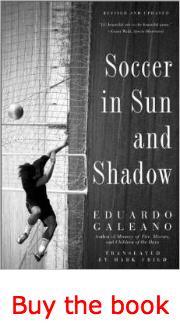
In 1969 war broke out between Honduras and El Salvador, two small and very poor Central American countries that for more than a century had been accumulating reasons to distrust one another. Each had always served as the magical explanation for the other’s problems. Hondurans have no work? Because Salvadorans come and take their jobs. Salvadorans are hungry? Because Hondurans mistreat them. Both countries believed their neighbor was the enemy, and the relentless military dictatorships of each did all they could to perpetuate the error.
This war was called the Soccer War because the sparks that set off the conflagration were struck in the stadiums of Tegucigalpa and San Salvador. The trouble began during the qualifying rounds for the 1970 World Cup. There were tussles, a few injuries, several deaths. A week later, the two countries broke off relations. Honduras expelled a hundred thousand Salvadoran peasants who had always worked in that country’s plantings and harvests; Salvadoran tanks crossed the border.
The war lasted a week and killed four thousand people. The two governments, dictatorships forged at a U.S. factory called the School of the Americas, fanned the fires of mutual hatred. In Tegucigalpa the slogan was “Honduran, don’t sit still, grab a stick and a Salvadoran kill.” In San Salvador: “Teach those barbarians a lesson.” The lords of land and war did not lose a drop of blood, while two barefoot peoples avenged their identical misfortunes by killing each other with abandon.
The End of the Match
The ball turns, the world turns. People suspect the sun is a burning ball that works all day and spends the night bouncing around the heavens while the moon does its shift, though science is somewhat doubtful. There is absolutely no question, however, that the world turns around a spinning ball: the final of the '94 World Cup was watched by more than two billion people, the largest crowd ever of the many that have assembled in this planet’s history. It is the passion most widely shared: many admirers of the ball play with her on fields and pastures, and many more have box seats in front of the TV and bite their nails as 22 men in shorts chase a ball and kick her to prove their love.
At the end of the ’94 Cup every child born in Brazil was named Romário, and the turf of the stadium in Los Angeles was sold off like pizza, at twenty dollars a slice. A bit of insanity worthy of a better cause? A primitive and vulgar business? A bag of tricks manipulated by the owners? I’m one of those who believe that soccer might be all that, but it is also much more: a feast for the eyes that watch it and a joy for the body that plays it. A reporter once asked German theologian Dorothee Sölle, “How would you explain happiness to a child?”
“I wouldn’t explain it,” she answered. “I’d toss him a ball and let him play.”
Professional soccer does everything to castrate that energy of happiness, but it survives in spite of all the spites. And maybe that’s why soccer never stops being astonishing. As my friend Ángel Ruocco says, that’s the best thing about it -- its stubborn capacity for surprise. The more the technocrats program it down to the smallest detail, the more the powerful manipulate it, soccer continues to be the art of the unforeseeable. When you least expect it, the impossible occurs, the dwarf teaches the giant a lesson, and a runty, bowlegged black man makes an athlete sculpted in Greece look ridiculous.
An astonishing void: official history ignores soccer. Contemporary history texts fail to mention it, even in passing, in countries where soccer has been and continues to be a primordial symbol of collective identity. I play therefore I am: a style of play is a way of being that reveals the unique profile of each community and affirms its right to be different. Tell me how you play and I’ll tell you who you are. For many years soccer has been played in different styles, unique expressions of the personality of each people, and the preservation of that diversity seems to me more necessary today than ever before. These are days of obligatory uniformity, in soccer and everything else. Never has the world been so unequal in the opportunities it offers and so equalizing in the habits it imposes. In this end-of-century world, whoever does not die of hunger dies of boredom.
For years I have felt challenged by the memory and reality of soccer, and I have tried to write something worthy of this great pagan mass able to speak such different languages and unleash such universal passion. By writing, I was going to do with my hands what I never could accomplish with my feet: irredeemable klutz, disgrace of the playing fields, I had no choice but to ask of words what the ball I so desired denied me.
From that challenge, and from that need for expiation, this book was born. Homage to soccer, celebration of its lights, denunciation of its shadows. I don’t know if it has turned out the way soccer would have liked, but I know it grew within me and has reached the final page, and now that it is born it is yours. And I feel that irreparable melancholy we all feel after making love and at the end of the match.
Eduardo Galeano is one of Latin America’s most distinguished writers. He is the author of a three-volume history of the Americas, Memory of Fire, and most recently, a history of humanity, Mirrors, as well as Children of the Days: A Calendar of Human History. He is the recipient of many international prizes, including the first Lannan Prize for Cultural Freedom, the Casa de las Américas Prize, and the First Distinguished Citizen of the region by the countries of Mercosur. These excerpts are taken from Soccer in Sun and Shadow, his 1997 book, translated by Mark Fried, and updated to include World Soccer Cup matches through 2010.
Excerpted from Soccer in Sun and Shadow. Copyright © 1997 by Eduardo Galeano and Mark Fried, translation. Published in paperback by Nation Books, 2013. Published in ebook by Open Road Media, 2014; available wherever ebooks are sold. By permission of Susan Bergholz Literary Services, New York City and Lamy, New Mexico. All rights reserved.
Courtesy:TomDispatch.com
Disclaimer: The views expressed here are the author's personal views, and do not necessarily represent the views of Newsclick
Get the latest reports & analysis with people's perspective on Protests, movements & deep analytical videos, discussions of the current affairs in your Telegram app. Subscribe to NewsClick's Telegram channel & get Real-Time updates on stories, as they get published on our website.










